Travels with Grace: Italy Part 1
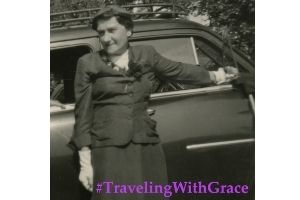
Welcome to this week’s segment of our 2019 #TravelTuesday series: Traveling with Grace. Today Grace shares her travel through Naples, Venice, and Milan!
July 6, 1929
This morning we are awakened by a great hustle and bustle on the docks at Naples. Another ship, the “Conte Biancamans” is in the slip next to ours and shortly after our arrival they pull out amidst great cheering and blowing of whistles. As we have been in Naples before and as the heat today is overpowering on shore, we remain on board where we can keep cooler and more comfortable, the while feasting our eyes on Naples’ white skyline dotted with umbrella trees and on the other side Vesuvius smoking away industriously in a bluish haze. We leave at 4 p.m. and the harbor is all bathed in blue and gold. We follow the coast line for some time, roads and houses plainly visible along the jutting, mountainous coast curving into many dark blue bays and inlets. We ride quite close to Capri and Anacapri snuggling into their little hollows between the rocks. Every day since we came aboard there has been published a little newspaper with the principal news and stock market quotations received by radio from New York, but today we were able to get the Paris edition of the Herald in Naples. Tonight about 11 o’clock we see the lighthouses along the coast of Sicily and intermittently the red flare from the volcano of Stromboli. The crowd on the boat has thinned out considerably and I miss my Italian friends, the only people we have frequented.
July 7, 1929
We come now and then in sight of land. This morning we pass Santa Maria di Leuca, at the heel of the boot of Italy. Every Sunday morning they celebrate high mass in the pretty little white and gold chapel next to our cabin and there is an archbishop on board who officiates in his red robes.
July 8, 1929
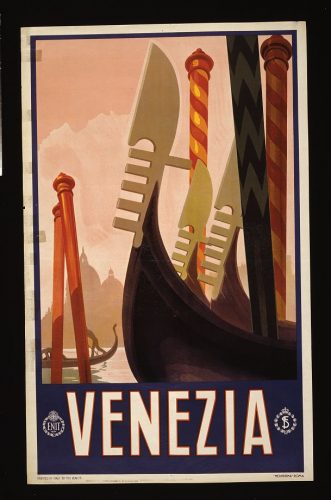
About 2 p.m. we ride into the Lagoon of Venice past the Lido, and right up to within a few yards of the Piazza di San Marco. This is the most beautiful approach to the Queen of the Adriatic and never did she look more queenly than today. As soon as we have dropped anchor, hundreds of little boats (gondolas, motor boats little and big, sculls, everything that floats) come swarming about us to take the passengers off. We are indeed a giant among pygmies. They say it is an unusual and difficult feat to conduct a large vessel such as this into so small a channel. We do not disembark, preferring to enjoy Venice in the “large” as the scope of our vision is very much ampler from the high vantage point of the promenade deck.
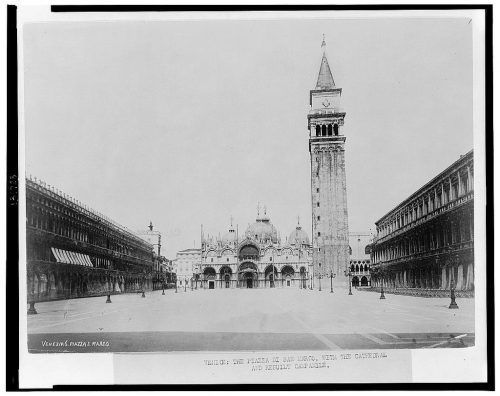
We see the beautiful façade of the Doge’s Palace, the domes of St. Mark’s cathedral peeping above it, the columns of St. Mark and St. Andrew, the Campanile, the golden angel on the weather-vane over the royal palace; the pretty green parks, the little canals opening up crooked vistas, the imposing church of Santa Maria della Salute on the Guidecca; all of the myriads of little islands, the network of bridges, the lovely old houses with their beautifully carved trefoil windows and doorways; all this and more like spread out below us and up to us float the cries of the gondoliers competing for trade. There are subjects for 1000 different pictures and how I wish I were an artist to interpret a few of them. The sunset throws another and a lovelier aspect on it, all rose and gold.
All day the Venetians and other foreign visitors are coming and going to visit the boat which is a great advertisement for the company. They are conducted through in squads under convoy of a steward. They pay five lire for the privilege and tonight the elite of Venice come on board to dine and dance to the tune of 100 lire, all of which money is turned over by the company to the war veterans. They are having a gay time in the ballroom tonight. These Italian girls appear much more refined and decorous than the American girls, at least superficially. We go out on deck for another view of Venice by night. It is even more bewitching than by the light of the setting sun. Lamps are shining everywhere, crowds are gathered on the quays, the piazza is black with people, the young crescent moon is just sliding out from behind the Campanile and men are singing out on the lagoon. We sail at midnight.
July 9, 1929
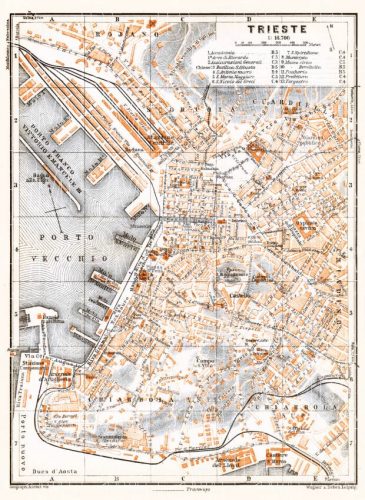
We awaken this morning to find ourselves approaching Trieste surrounded by hills. We go to the Excelsior Savoy Palace and are met by Cook’s guide who takes us around the city. It is a very clean and quiet place, principal industries shipping and ship building. The Cosulieh Line is building a fine new pier right opposite this hotel. There are some nice looking buildings, especially banks, a fine opera house, monument to Rossini, Verdi, Garibaldi, a beautiful new synagogue, one of the handsomest I ever saw, some nice stores (the principal one owned by Ohler, an Austrian), the beautiful victory lighthouse, a naval war memorial, standing high on the cliffs overlooking the Adriatic.
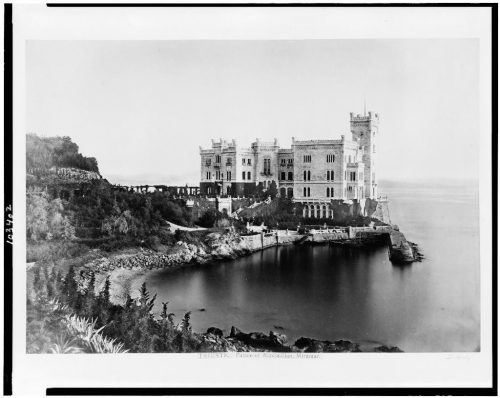
We ride to the Miramar Castle, a most romantic bit of rococo architecture built on rocks at the edge of a peninsula. In front of it is a beautiful wooded park and sunken gardens, behind it the wide expanse of sea. Here dwelt Maximilian and his consort Charlotte before their unfortunate adventure into Mexico. The palace is beautifully furnished. There are many paintings, mostly copies of famous masterpieces, and some samples from Charlotte’s own brush. There are pretty bits of porcelain, bronze work, a magnificent chest of drawers in marquetry inset with ovals of flowered porcelain, bed covers, chairs and window hangings of sky blue brocade, bathroom with a grey marble tub, in one room a fluted column encircled by electric push buttons, each marked for a different servant. The director grants me the special privilege of allowing my car to drive up to the doorway and he presents me with a lovely bouquet of flowers from the garden. We have luncheon at a little terrace restaurant overlooking the sea. We visit the ancient Cathedral of San Guisto containing some old paintings by Tiutoretto.
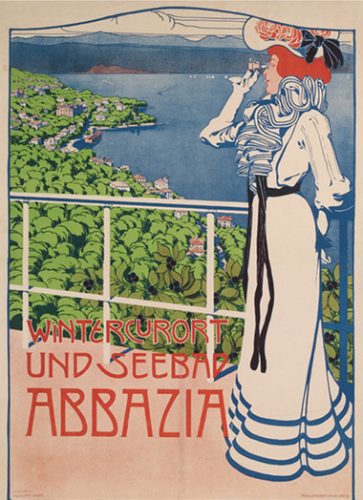
Then we go for a long ride to Fiume and Abazzia. The former is a nice town, smaller than Trieste, lying on the Yugoslavian border. In fact, we ride up to the bridge separating Fiurne from Sousak, Yugoslavia. On one side the stores have Italian wording, on the other the letters look like Russian and are wholly unintelligible to us. Abazzia is a beautiful little resort facing the sea, its many lovely villas, pensions and hotels reminding me strongly of Menton and San Remo. The country separating these towns from Trieste is rolling and very fertile. We ride through picturesque villages and rich farms. The little wheat fields planted in the hollows look to me like thick yellow fur rugs flung down on a bright green floor. Diminutive donkeys are used extensively as beasts of burden. Another characteristic sight is women and young girls balancing huge baskets full of various articles on clothes coiled on their heads while walking along with their arms swinging freely. This gives them a very graceful carriage. In the evening a band plays in the park in Trieste and on a tree-lined promenade the beaux and belles walk leisurely or stop for a drink or an ice at the numerous sidewalk cafes which are ubiquitous. It is delightfully cool here.
July 10, 1929
We have another interesting ride today. We go to Postumia to visit the caves. Upon arrival here we have luncheon at the restaurant run by the government, a new and very attractive place commanding a beautiful view. A little electric railway carries us through the caves, said to be the largest in the world and in here it is cold and damp. We hire extra coats and are glad to have them. It is my first visit to a place of this sort and I am much impressed by the wonderful natural formations, stalactites and stalagmites. One of the prettiest things is a stone ruffle in beautifully marked stone which hangs down exactly like a jabot. There is another bit which looks like the bent figure of an old man which they call Moses. He has a long beard and seems to be leaning on a staff. There is a natural pulpit and an organ, a large hall where they hold dances and where the stands are set for the orchestra. They are going to open a bar in here too and I think it will be well patronized. There is what they call a snow mountain in a place where the rock is very white in contract with the buffs and reds all around. A stream of water, said to be very deep, runs through the cave and in it are blind fish that look like exaggerated worms. They feed them every three months with liver. It takes two hours to see everything.
July 11, 1929
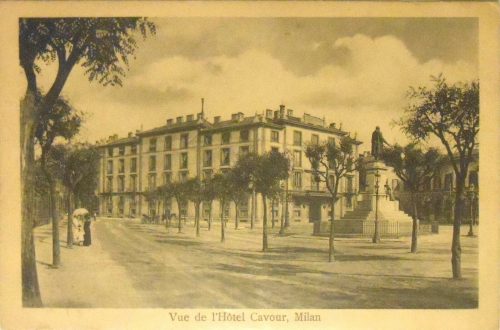
We leave Trieste at 10:40 a.m., change cars at Mestie and arrive in Milan at 6:30 p.m. On the train we meet some interesting people, an Austrian captain and his aunt and a young Italian. They all speak Italian in addition to French, German, English, and the Italian, who has lived in South America, also speaks Spanish. In Milan we go to the Hotel Cavour where the director remembers us, greets us cordially and assigns us to a most magnificent suite overlooking the park. Here there is a concert tonight.
July 12, 1929
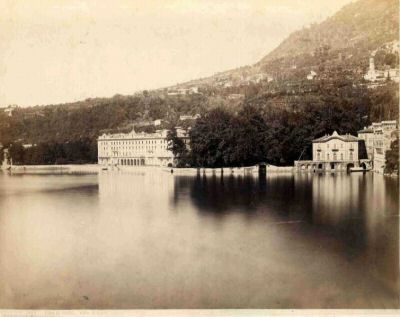
Before leaving Milan this morning in comfortable private auto, we make a swift tour of the city, the metropolis of Italy, in order to strengthen our impressions of two years ago. The superb Cathedral, the Sforza citadel, Arch de Triomphe, statues of Victor Emanuel II, Dante, etc., the arcades, the Monumental cemetery, the Arena, all are reviewed like old, admired friends. Then we start on our trip to Como. We come to Villa d’Este at Cernobbia and this is indeed “el Paradiso.” I am simply in ecstasies over the hotel and all its surroundings. Our rooms face the garden and lake and the opposite hills. The hotel is not very crowded.
July 13, 1929
Today, Saturday, we luxuriate in the garden which is provided with very comfortable chairs. We make the acquaintance of the Misses Brenner of New York and have a pleasant chat with them. The air is sweet with magnolias, heliotrope, jasmine and roses. There are lovely parterres of flowers of different kinds on the lawn. An avenue of tall cypresses climbs the holl in back of the hotel and cascades of water splash down steps on either side. At the foot of this ornamental vista is the “Mosaica” with its pattern of colored stones and carved insets of bas reliefs. Magnificent trees dot the slopes; perched high above are the ruins of several old castles with crenelated roofs and towers. On the lake there is a busy traffic: row boats, canoes, launches, high powered motor boats and little steamers plying from quay to quay. Toward dusk the little lights begin to twinkle in the water and from the surrounding hills. The lighthouse on the topmost peak opposite sends its search light swinging round to light up everything. The music plays soft, lyric things. It is dreamy and peaceful. About 10:30 we walk over to watch the dancing in the beautiful ballroom. The girls look lovely floating around in their soft chiffons and laces. (We had dinner out on the terrace restaurant. The shaded glow from the many little lamps penetrate the trees and shrubbery and it all looks like a veritable fairyland.) Weather continues ideal.
Thanks for reading “Traveling with Grace,” a series where we’re sharing (and annotating) posts from the travel diaries of Grace Amelia Hecht, native Baltimorean, b. 1897 and d. 1955. Next week we’ll continue with Grace’s Italian travels. As mentioned in my introductory post transcription errors sometimes occur and I’ve made my best guesses where possible, denoted by [brackets]. – Rachel Kassman, marketing manager
